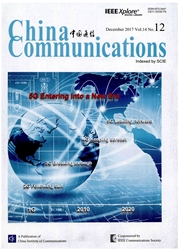

 中文摘要:
中文摘要:
In this paper,a two-way relay system which achieves bi-directional communication via a multiple-antenna relay in two time slots is studied.In the multiple access(MA) phase,the novel receive schemes based on Dempster-Shafer(D-S) evidence theory are proposed at the relay node.Instead of traditional linear detection,the first proposed MIMO-DS NC scheme adopts D-S evidence theory to detect the signals of each source node before mapping them into network-coded signal.Moreover,different from traditional physical-layer network coding(PNC) based on virtual MIMO model,the further proposed MIMO-DS PNC comes from the vector space perspective and combines PNC mapping with D-S theory to obtain network-coded signal without estimating each source node signal.D-S theory can appropriately characterize uncertainty and make full use of multiple evidence source information by Dempster’s combination rule to obtain reliable decisions.In the broadcast(BC) phase,the space-time coding(STC) and antenna selection(AS) schemes are adopted to achieve transmit diversity.Simulation results reveal that the STC and AS schemes both achieve full transmit diversity in the BC phase and the proposed MIMO-DS NC/PNC schemes obtain better end-to-end BER performance and throughputs compared with traditional schemes with a little complexity increasing and no matter which scheme is adopted in the BC phase,MIMO-DS PNC always achieves full end-to-end diversity gain as MIMO-ML NC but with a lower complexity and its throughput approaches the throughput of MIMO-ML NC in high SNR regime.
 英文摘要:
英文摘要:
In this paper,a two-way relay system which achieves bi-directional communication via a multiple-antenna relay in two time slots is studied.In the multiple access(MA) phase,the novel receive schemes based on Dempster-Shafer(D-S) evidence theory are proposed at the relay node.Instead of traditional linear detection,the first proposed MIMO-DS NC scheme adopts D-S evidence theory to detect the signals of each source node before mapping them into network-coded signal.Moreover,different from traditional physical-layer network coding(PNC) based on virtual MIMO model,the further proposed MIMO-DS PNC comes from the vector space perspective and combines PNC mapping with D-S theory to obtain network-coded signal without estimating each source node signal.D-S theory can appropriately characterize uncertainty and make full use of multiple evidence source information by Dempster's combination rule to obtain reliable decisions.In the broadcast(BC) phase,the space-time coding(STC) and antenna selection(AS) schemes are adopted to achieve transmit diversity.Simulation results reveal that the STC and AS schemes both achieve full transmit diversity in the BC phase and the proposed MIMO-DS NC/PNC schemes obtain better end-to-end BER performance and throughputs compared with traditional schemes with a little complexity increasing and no matter which scheme is adopted in the BC phase,MIMO-DS PNC always achieves full end-to-end diversity gain as MIMO-ML NC but with a lower complexity and its throughput approaches the throughput of MIMO-ML NC in high SNR regime.
 同期刊论文项目
同期刊论文项目
 同项目期刊论文
同项目期刊论文
 Iterative Channel Estimation and Detection for High-Mobility MIMO-OFDM Systems Mitigating Error Prop
Iterative Channel Estimation and Detection for High-Mobility MIMO-OFDM Systems Mitigating Error Prop 期刊信息
期刊信息
